Protocol - Alcohol - 30-Day Quantity and Frequency
- Alcohol - Maximum Drinks in 24 Hours
- Substance Abuse and Dependence - Past Year - Alcohol
- Substance Abuse and Dependence - Past Year - Drugs
- Substance Abuse and Dependence - Past Year - Tobacco
Description
Measurements of respondent’s 30-day quantity and frequency of consumption of alcohol.
Specific Instructions
Respondents are asked the 30-day frequency question only if they answered "yes" to the Alcohol - Lifetime Use measure. Alcohol is defined as any type of alcohol (including coolers, beer, wine, champagne) and liquor (e.g., whiskey, rum, gin, vodka, scotch, or liqueurs).
Availability
This protocol is freely available; permission not required for use.
Protocol
The Working Group acknowledges that the following questions may gather sensitive information relating to the use of substances and/or illegal conduct. If the information is released it might be damaging to an individual’s employability, lead to social stigmatization, or other consequences.
For information on obtaining a Certificate of Confidentiality, which helps researchers protect the privacy of human research participants, please go to the National Human Genome Research Institute’s Institutional Review Board website.
Respondents are asked the following two questions: one regarding the frequency of consumption (number of days), and a second regarding the usual quantity of consumption (number of drinks) on drinking days.
1. Think specifically about the past 30 days, from [DATEFILL*], up to and including today. During the past 30 days, on how many days did you drink one or more drinks of an alcoholic beverage?
# OF DAYS: ____ [RANGE: 0 - 30]
Don’t Know / Refused
2. On the days that you drank during the past 30 days, how many drinks did you usually have each day? Count as a drink a can or bottle of beer; a wine cooler or a glass of wine, champagne, or sherry; a shot of liquor or a mixed drink or cocktail.
# OF DRINKS: ____ [RANGE: 1 - 90]
Don’t Know / Refused
* DATEFILL is the date 30 days prior to the date of the interview.
Notes to interviewer:
- Definition of a standard drink: 1 12oz bottle of beer, 1 glass 4oz non-fortified wine, 1 mixed drink with 1oz liquor.
- If respondent needs a visual reference for the size of a drink, the flashcards from the Wave 1 National Epidemiologic Survey on Alcohol and Related Conditions (NESARC) study are provided below:
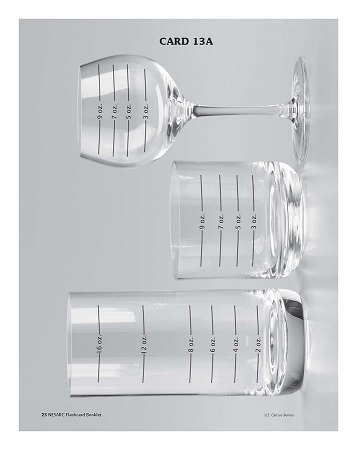
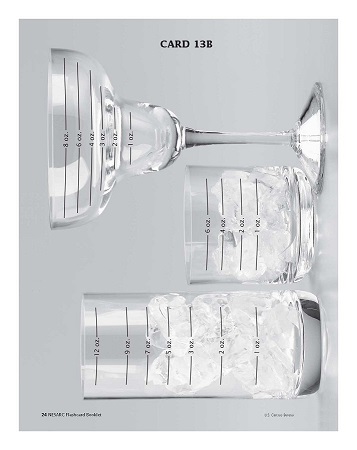

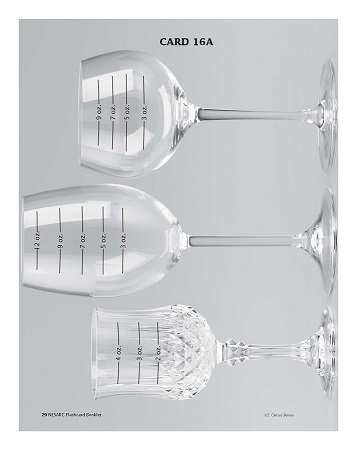
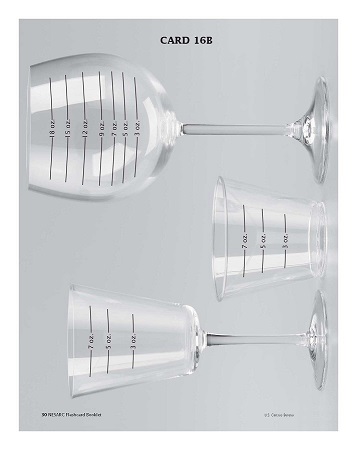
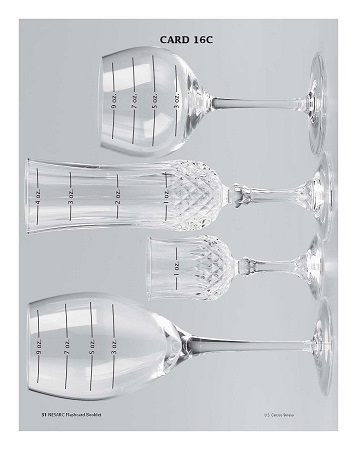

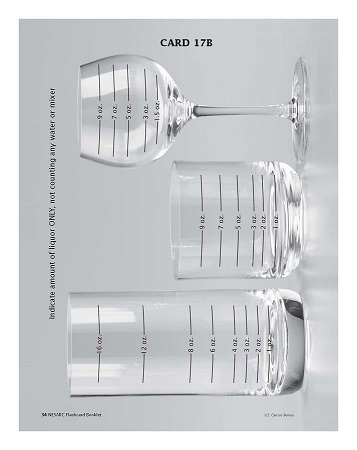
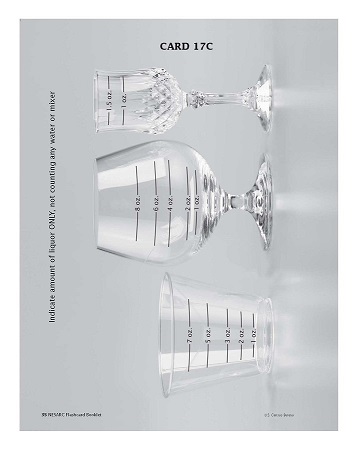
Personnel and Training Required
If an interviewer prepares the survey for self-administration, the interviewer must be trained and found competent to conduct personal interviews with individuals from the general population.
Equipment Needs
While the source instrument was developed for administration by computer, the PhenX Working Group acknowledges that these questions can be administered in a noncomputerized format.
Requirements
| Requirement Category | Required |
|---|---|
| Major equipment | No |
| Specialized training | No |
| Specialized requirements for biospecimen collection | No |
| Average time of greater than 15 minutes in an unaffected individual | No |
Mode of Administration
Self-administered questionnaire
Lifestage
Adult
Participants
≥18 years of age
Selection Rationale
The protocol from the National Survey on Drug Use and Health was selected because this survey is a primary source of information on the 30-day use of drugs, alcohol, and tobacco in the civilian, noninstitutionalized population of the United States. The study was initiated in 1971 and is currently conducted on an annual basis.
Language
Chinese, English, Other languages available at source
Standards
| Standard | Name | ID | Source |
|---|---|---|---|
| Logical Observation Identifiers Names and Codes (LOINC) | Alcohol 30D quantity frequency proto | 62547-5 | LOINC |
| Human Phenotype Ontology | Alcoholism | HP:0030955 | HPO |
| caDSR Form | PhenX PX030301 - Alcohol 30 Day Quantity And Frequency | 5807737 | caDSR Form |
Derived Variables
None
Process and Review
The Expert Review Panel #3 (ERP 3) reviewed the measures in Alcohol, Tobacco and Other Substances, and Substance Abuse and Addiction domains.
Guidance from ERP 3 includes:
• No significant changes to measure
Back-compatible: NA no changes to Data Dictionary
Previous version in Toolkit archive (link)
Protocol Name from Source
National Survey on Drug Use and Health (NSDUH), 2015 & National Institute on Alcohol Abuse and Alcoholism (NIAAA) National Epidemiologic Survey on Alcohol and Related Conditions, Wave 1 (NESARC - WAVE 1)/Alcohol Use Disorder and Associated Disabilities Interview Schedule-IV (AUDADIS-IV)
Source
2008 National Survey on Drug Use and Health. CAI Specifications for Programming, English Version; November 2007. (questions AL06 and AL07).
National Institute on Alcohol Abuse and Alcoholism (NIAAA) National Epidemiologic Survey on Alcohol and Related Conditions. Wave 1 (NESARC - WAVE 1). Alcohol Use Disorder and Associated Disabilities Interview Schedule - Diagnostic and Statistical Manual of Mental Disorders. Fourth Edition Version (AUDADIS-IV). Flashcard Booklet, Flashcards 13A-C, 16A-C, and 17A-C.
Grant, B. F., Dawson, D. A., Stinson, F. S., Chou, P. S., Kay, W., & Pickering R. (2003). The Alcohol Use Disorder and Associated Disabilities Interview Schedule-IV (AUDADIS-IV): Reliability of alcohol consumption, tobacco use, family history of depression and psychiatric diagnostic modules in a general population sample. Drug and Alcohol Dependence, 71(1), 7-16.
General References
For information regarding alcohol consumption during the last 30 days among women who are pregnant, please refer to the Centers for Disease Control and Prevention (CDC) National Center on Birth Defects & Developmental Disabilities Fetal Alcohol Syndrome website and the CDC Behavioral Risk Factor Surveillance System website.
Protocol ID
30301
Variables
Export Variables| Variable Name | Variable ID | Variable Description | dbGaP Mapping | |
|---|---|---|---|---|
| PX030301_Alcohol_30Day_Frequency | ||||
| PX030301010000 | Think specifically about the past 30 days, more | Variable Mapping | ||
| PX030301_Alcohol_30Day_Frequency_Coded | ||||
| PX030301010100 | Think specifically about the past 30 days, more | N/A | ||
| PX030301_Alcohol_30Day_Quantity | ||||
| PX030301020000 | On the days that you drank during the past more | Variable Mapping | ||
| PX030301_Alcohol_30Day_Quantity_Coded | ||||
| PX030301020100 | On the days that you drank during the past more | N/A | ||
Measure Name
Alcohol - 30-Day Quantity and Frequency
Release Date
February 6, 2009
Definition
Questions asking the respondent about quantity and frequency of alcohol consumption during the past 30 days.
Purpose
This measure can be used to assess the participant’s recent consumption of alcohol. The potential of recall bias can be reduced by assessing the respondent’s recent use.
Keywords
alcohol, exposure, alcohol use, alcohol abuse, alcohol use, coolers, beer, wine, champagne, liquor, whiskey, rum, gin, vodka, scotch, liqueurs, sherry, cocktail, mixed drink, National Institute on Alcohol Abuse and Alcoholism, NIAAA, National Epidemiologic Survey on Alcohol and Related Conditions, NESARC, Alcohol Use Disorder and Associated Disabilities Interview Schedule, AUDADIS, Diagnostic and Statistical Manual of Mental Disorders, National Survey on Drug Use and Health, NSDUH, gerontology, aging, geriatrics
Measure Protocols
| Protocol ID | Protocol Name |
|---|---|
| 30301 | Alcohol - 30-Day Quantity and Frequency |